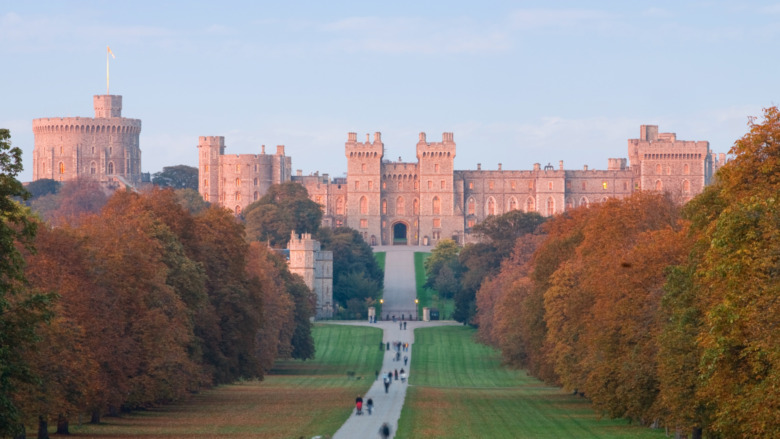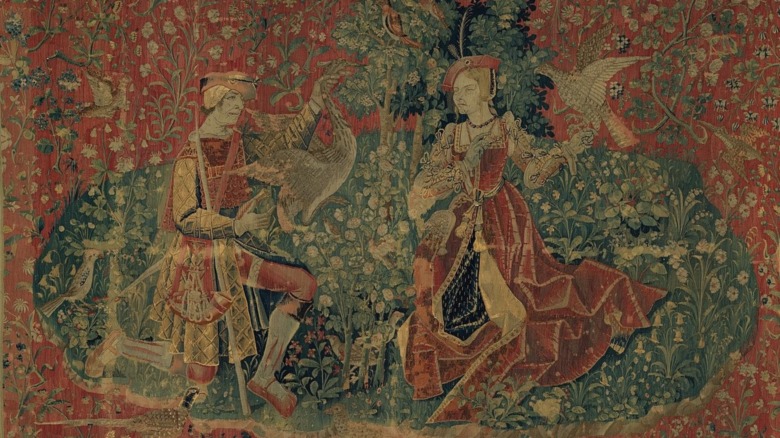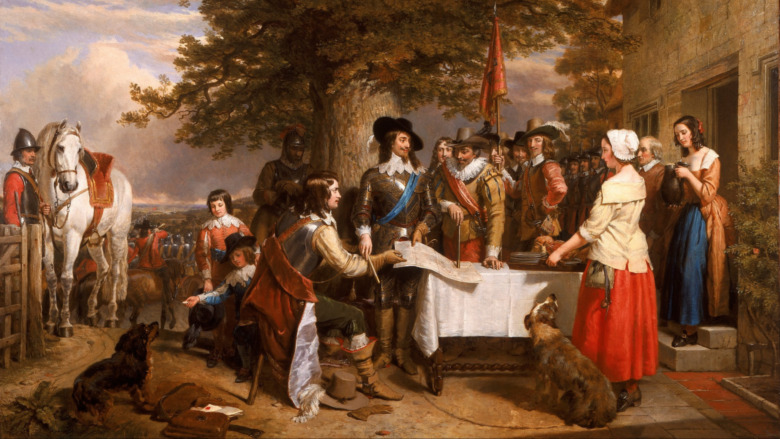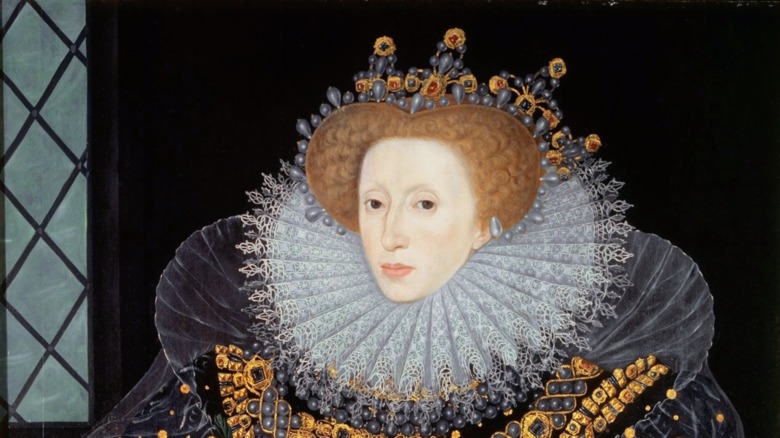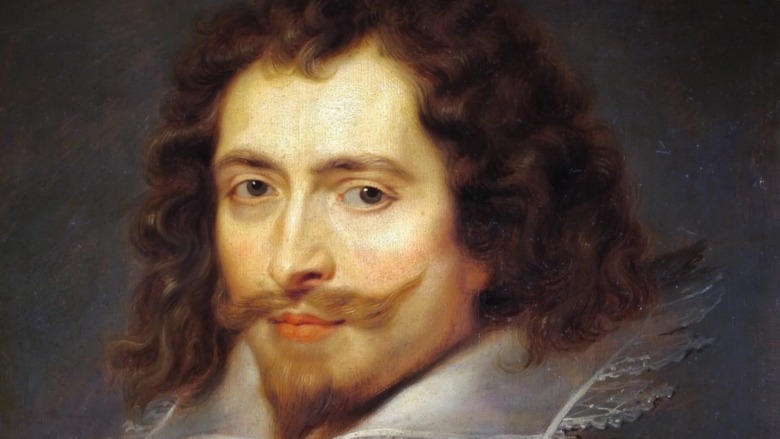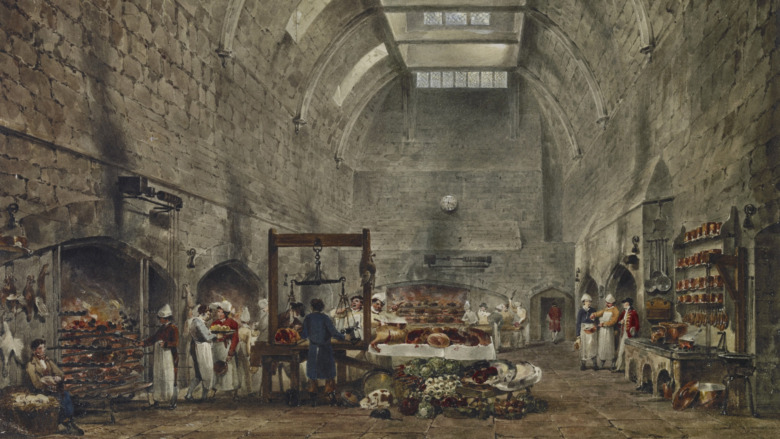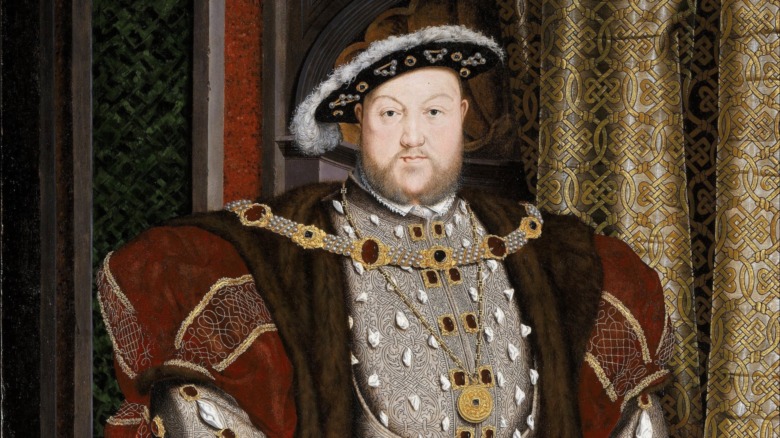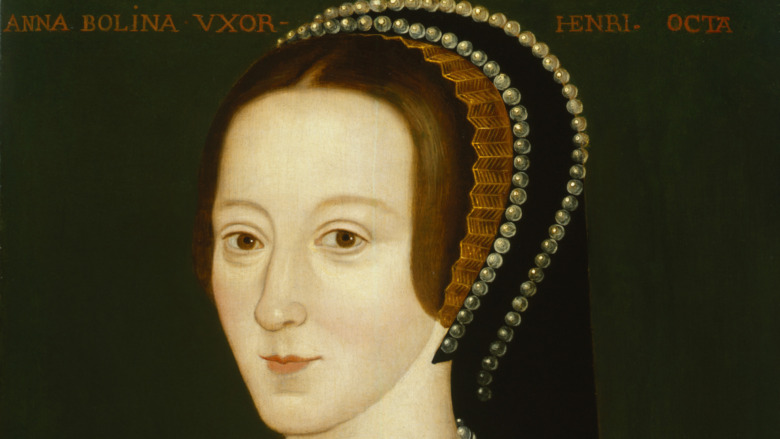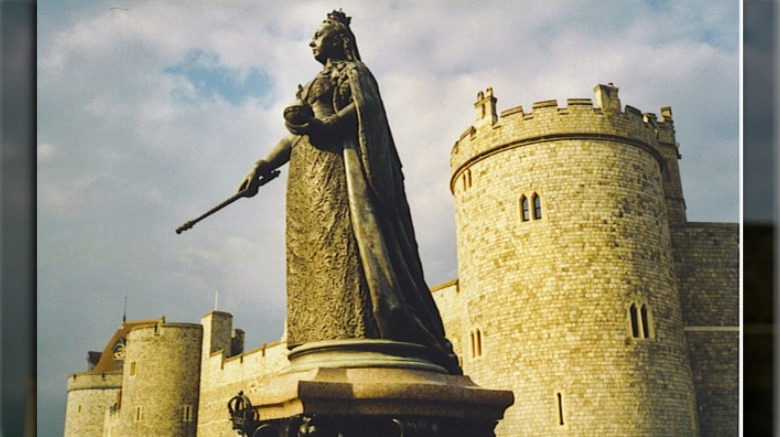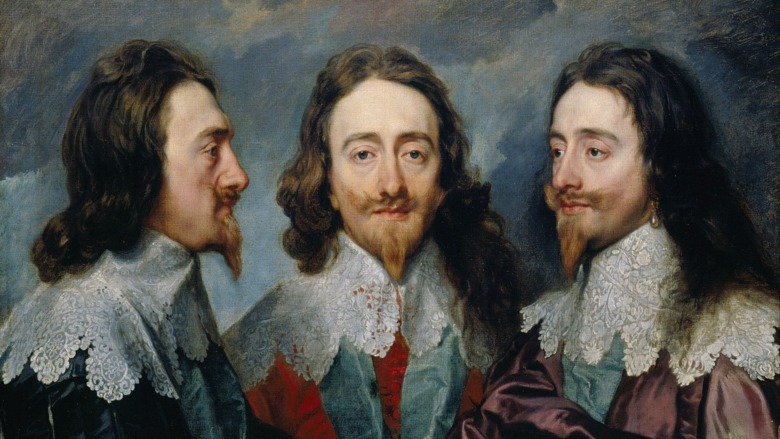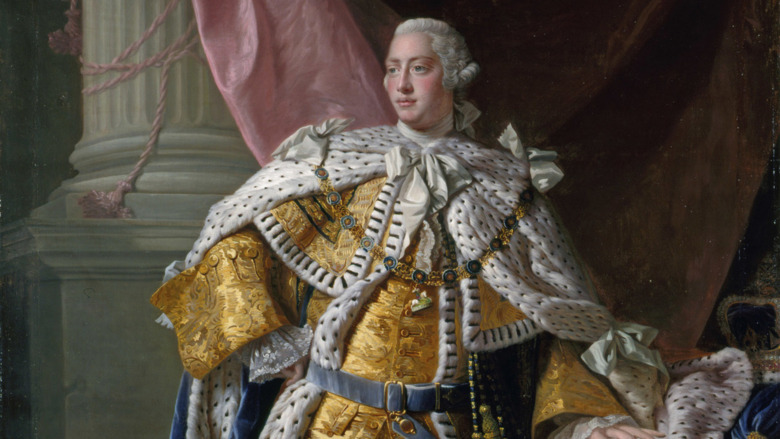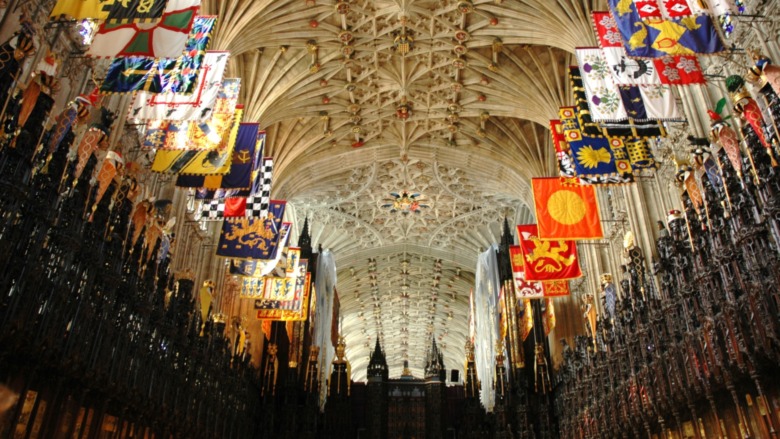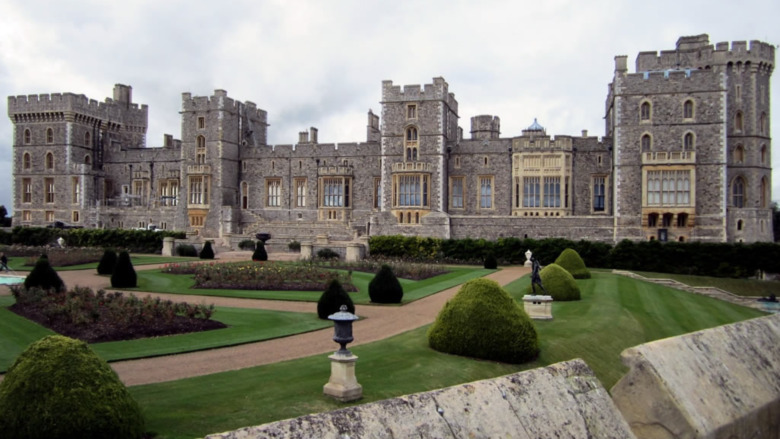Ghosts That Haunt Windsor Castle
In the world of ghost stories, what could be more classic and compelling than a haunted castle? Sure, a more domestic story like, say, "The Amityville Horror" or "Poltergeist," where suburbia is plagued by spirits both good and evil, is probably more accessible. But don't deny that you still kind of want to roam the halls of an old castle, maybe with a candelabra in hand, and encounter the spirit of a long-departed queen or a mysterious, ancient soldier.
That may be overly poetic for most people but, for the British royal family, the prospect of living side by side with a bunch of ghosts could very well be their reality. Of course, that depends on the castle in question. According to Veranda, the royal family owns 26 residences, which range from a tiny Welsh cottage-turned-children's playhouse to the grandiose spectacle of London's Buckingham Palace. Some, it's plain to see, are simply better settings for gothic-style ghost stories.
The oldest of all the royal residences is Windsor Castle, now nearly over 900 years old (via Royal Collection Trust). With centuries of royal occupation and all of the colorful and sometimes tragic history that it encompasses, it's no wonder that a wealth of ghost stories center on the castle and its grounds. From mysterious footsteps and voices to the full-body apparitions of kings and queens long gone, there's a ghost story for everyone who comes looking for them at Windsor.
Herne the Hunter is a notorious Windsor Castle spirit
If you ever visit Windsor Castle and work up the courage to ask your tour guide about any possible hauntings — someone always asks, one way or another — then you'll almost certainly hear about a legend that tells the tale of Herne the Hunter. This famous ghost has supposedly been stalking the grounds of the castle for centuries, entrancing many with his tragic story and spooky afterlife.
As the BBC reports, Herne is often reportedly sighted in the Great Park, the large outdoor space near the castle. The legend maintains that he was a favorite huntsman of the medieval King Richard II, having gained the monarch's favor by saving him from a gruesome death at the horns of an angry stag. "Ghosts" notes that some versions of the tale have it that Herne was healed via magic, a potentially scandalous medical technique in an era when accused witches weren't exactly held up as paragons of virtue.
Being the king's buddy, however, was a double-edged sword for Herne. He may have enjoyed royal favor, but it's said that his colleagues grew jealous of his special treatment and conspired against him. These jealous people framed Herne for theft. Distraught at the accusation, Herne then killed himself. He's now said to roam the Great Park, looking for spirits to join him in his hunt.
Ghosts of the English civil wars may linger there
While all war is awful, civil wars often seem to have an especially traumatic effect on a country and its people. Perhaps that's why ghosts of the English civil wars, both figurative and literal, still seem to linger in Britain centuries after the conflict was officially over. According to History, the English civil wars began as tension between the king, Charles I, and Parliament over how to handle rebellious Irish forces. It eventually bloomed into a bloody fight over whether it was the king or Parliament who should take charge of England.
Eventually, Oliver Cromwell, head of the "Parliamentarians,” won. He dramatically marked the occasion by beheading Charles I, the focus of the "Royalist" cause. All told, some 34,000 people loyal to Cromwell had died, while the wars took the lives of an estimated 50,000 Royalists.
Even a royal castle like Windsor can't seem to escape this death-filled legacy. Its Norman Tower is home to a "Prison Room" which, according to the BBC, still potentially houses a long-dead Royalist detainee. Creepily enough, children are said to see him and have reported as such while playing there. Adults can't spot him, however, but can still feel the ghostly man brush past them, unseen.
Elizabeth I reportedly appears in the Windsor Castle library
Of course, it would not be much of a haunted castle in Britain if there weren't a few British royals who are said to linger around the place, long after their physical bodies gave up. And who would make a more striking royal ghost than the bejeweled and very intimidating personage of Queen Elizabeth I?
Per Reader's Digest, Elizabeth I, who died in 1603, returns occasionally near the library, sometimes disappearing in another room. She's apparently a bit notorious for appearing to members of the royal family. The 18th century King George III, himself now a purported spirit of Windsor, is said to have encountered a woman dressed all in black fitting the queen's description. As Elizabeth often said during her life, this specter told George III that she was "married to England." King Edward VII, son of Queen Victoria, also claimed to have seen a similar ghost, British Paranormal reports, though, in keeping with his rather scandalous nature, Edward confided this encounter to one of his mistresses.
Both are pretty great stories, but King George VI may well have his predecessors beat. Per Royal Central, Elizabeth I appeared to the father of Elizabeth II for eight straight nights. Given that World War II was just about to break out in a conflict that would see the region bombed over and over in the Blitz, it could be that the first Queen Elizabeth appeared as a kind of ghostly royal warning.
One ghost reportedly appeared to predict his son's assassination
In the 17th century, a ghost appeared to an officer at Windsor. Per the "Selected Essays of Henry Fielding," the ghost predicted his son's death and told the officer to warn his son. But this wasn't any old ghost with a warning for some person that's now lost to history. This was the dead Sir George Villiers, who was instantly recognizable to the man. The officer seems to have taken it seriously enough after multiple encounters and so told the dead man's son, who was greatly disturbed by the story.
His son was (also) George Villiers, first duke of Buckingham, who was King James I's favorite. As in really his favorite, to the point where modern historians are still debating if the duke of Buckingham and King James I were romantically entangled (via Atlas Obscura). Regardless of whether or not Buckingham was in an amorous relationship with the king, they were so close as to inspire both jealousy and reported bad behavior from George, who wasn't shy about flaunting his power. The ghostly father of the duke of Buckingham may not have cared or known about all that, but it was also unsuccessful. The duke would be assassinated anyway in 1628.
Windsor Castle's kitchen hosts multiple ghosts
Even the kitchens of Windsor aren't exempt from the ghosts that are packed onto the historic grounds of this castle. As The Royal Family revealed, those kitchens are a pretty well-appointed and expansive sort of place with room for a full staff with a few ghosts to spare — this is still a royal castle, after all.
According to the BBC, one of the ghosts occasionally spotted around here is a man leading a horse. That might seem pretty anodyne, at first, since neither the man nor the horse are known to be royals, but the pair then dramatically disappears into a wall in the kitchen. Given that the area was once part of the old cavalry stables on the grounds, it's not all that shocking that the ghost of a groom and his horse might now be spotted nearby.
The pair aren't alone, it's said. The Crown Chronicles reports that the same kitchens are host to the specter of a small girl, once spotted standing near a Christmas tree. The blue-clad girl is also sometimes accompanied by a spectral "white lady," a pretty classic type of haunting in Britain and Ireland, according to the journal Folklore. What castle would be complete without one?
The ghost of Henry VIII is said to moan in the halls
Perhaps the most notorious ghost at Windsor Castle is that of Henry VIII, who was also a pretty notorious ruler during his 16th century life. Given that his remains are buried in St. George's Chapel on the castle grounds, as History Extra reports, it may come as no surprise that many accounts maintain that King Henry still makes a visit from time to time.
The returned spirit of Henry VIII doesn't appear to be an especially happy one, however. "Ghosts" says that he's been spotted walking around the castle, though his disembodied moaning and yelling is more often reported in the nearby cloisters of the castle. Some have also said that they hear Henry dragging his leg, which is understandable since the king spent a fair amount of his final years with an ulcerated leg that never quite healed (via Historic UK). His steadily declining physical health caused Henry great pain and, if the stories of his spirit at Windsor are to be believed, may still be tormenting him after his death.
Anne Boleyn's ghost is reported to occasionally haunt Windsor Castle
Henry VIII's second wife, Anne Boleyn, is sometimes spotted by people who see her looking sadly out of a window of the Dean's Cloister at Windsor, where she's also occasionally seen to be weeping, according to Royal Central. Given that Henry had her executed in 1536, one understands why she's so down in the dumps, especially if her spirit has to encounter the ghost of her husband.
It must be said that Anne's ghost really gets around, if the stories are to be believed. According to Haunted Rooms, her specter not only appears at Windsor Castle but at Hever Castle, Marwell Hall, and the infamous Tower of London, where she was beheaded.
The most lurid tales of Anne Boleyn's ghost seem to center on Blickling Hall, on the site of her birthplace in Norfolk, England. Per the National Trust, her headless ghost is said to pull up to the manor house on May 19, the anniversary of her execution. She arrives at night, of course, and for a little extra touch, her carriage is conducted by a fellow headless figure. Other local legends connect the news of her death with the sighting of four ghostly horses also — yes, you guessed it — missing their own heads. At least the version of Anne that appears at Windsor seems to be fully intact.
Queen Victoria may have returned as a ghost to protest gardening changes
Family can be tough. It may sometimes seem as if everyone is arguing over some silly little thing, whether it's a new haircut, college applications, when someone is or isn't having a baby, and on and on. Add in the pressures of being a royal almost constantly in the public eye, and it can't be much easier for the British royal family (though all of those castles and the money must be nice).
Take the dispute over gardening between Queen Victoria and her great-grandson, King Edward VIII. Edward, who would eventually abdicate his throne to marry the American divorcee Wallis Simpson, surely thought he was in the clear for a little landscaping. After all, those trees planted by Victoria had been there for many years, and Victoria herself was long gone. Who would object?
Victoria did, according to British Paranormal. When the king ordered gardeners to pull up some spruce trees planted by Victoria and her husband, Prince Albert, the workers were plagued by strange happenings. Eventually, it all culminated in a sighting of Victoria herself, waving her arms and moaning as she marched towards them. The trees are said to remain even today.
Charles I reportedly walks through the Windsor cloister
As if one headless royal wasn't enough, it's said that Windsor Castle is actually haunted by two. Anne Boleyn, the doomed second wife of Tudor King Henry VIII, is reportedly joined by the ghost of Charles I.
Per Britannica, Charles I was the king of Great Britain and Ireland, reigning from 1625 until January 30, 1649. That's when he was executed, ostensibly for committing treason. Parliamentarians, led by Oliver Cromwell, would reign over England in Puritan-imposed austerity until the return of the monarchy with Charles II in 1660.
Now, according to the College of St. George, the ghost of Charles I may still be spotted walking through the chapel cloisters, though thankfully with his head still attached to his spectral shoulders. That may not be entirely surprising to some, given that the king's mortal remains are interred right there in the chapel. He may range a little further afield, as Royal Central reports that he's also been spotted in Windsor Castle's library.
The spirit of George III may be seen staring out of a window
After a while, it may seem like Windsor Castle is seemingly packed with the ghosts of long-departed royals. One of the more frequently recorded ghosts said to be spotted at Windsor is yet another king, in particular the gloomy spirit of poor, confined King George III.
Per History, George III reigned for nearly 60 years, making him one of the longest-reigning monarchs in British history. Yet his rule, which lasted from 1760 until his death in 1820, was marred by progressively intense episodes of mental illness beginning in 1778, which frequently left the king incoherent and unable to rule. Eventually his son, the future George IV, became the prince regent and ruled in his stead.
During his periods of instability, George was typically confined to a given space within a castle. And, according to British Folklore, that's where something of the king has remained at Windsor Castle. It's said that he would sometimes look out of the windows there. When guards saw him, they would salute, and he would raise his hand in return. He apparently kept doing this after his death. Royal Central maintains that a group of guards automatically saluted the king as he looked out the window — even though it was a few days after George's death, and his remains were already lying in state at the castle (via Georgian Papers Programme).
Windsor Castle's Deanery is reportedly haunted by multiple ghosts
The traditional residence of the dean for St. George's Chapel on Windsor's grounds is not exempt from hauntings, despite the ostensibly holy presence there. Indeed, it appears that multiple unnamed spirits are sharing the space.
The BBC reports that an unidentified young boy may sometimes be heard shouting "I don't want to go riding today," though one suspects that the boy in question is long gone or at least doesn't have to worry about whatever horse riding was proving so bothersome to him.
Thankfully for his sake, it appears that the ghostly voice of this young boy isn't alone. The College of St. George claims that the nearby hallways sometimes echo with footsteps, though the walker in question is nowhere to be seen. And the northern entrance to the Deanery has been occupied by a mysterious woman in gray. Like her spectral cousin, the "white lady," a "grey lady" ghost is by now a classic of hauntings seemingly everywhere, from Scotland's Glamis Castle (via "Ghosts") to Indiana (via River City Weekend).
One 19th century visitor had a chilling encounter with an unusual set of statues
Even the very statuary at Windsor Castle holds the chance for some truly chilling encounters with the supernatural. Sure, it may seem a bit silly, but try and tell that to one visitor in 1873 who claimed to have an incredibly eerie encounter on the grounds of the royal residence.
As the BBC relates, the visitor in question was taking a nighttime walk around the grounds of Windsor — remember, this was the 19th century, in an era where you could potentially do that sort of thing and not get tackled to the ground by a guard. While wandering near St. George's Chapel, the visitor spotted a new group of statues that had been placed nearby. It consisted of four figures, with one bent near the ground and the other three standing. All were clad in black. Most alarmingly, one of the standing figures had a sword raised in one hand, as if it were about to fall and perhaps hit the crouching figure.
Naturally enough, the visitor asked a nearby guard about the dramatic and rather odd set of statues. But the guard had no idea that any statues had been erected on the grounds. Even worse, when the visitor returned in the light of day, the unnerving artwork was nowhere to be found.
